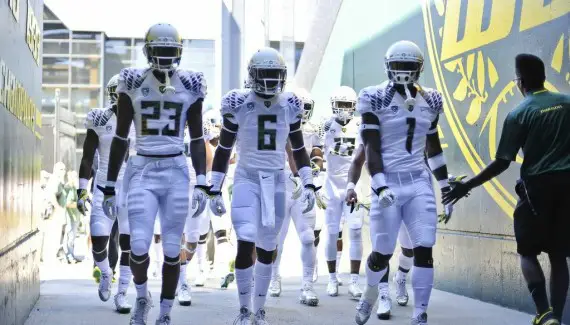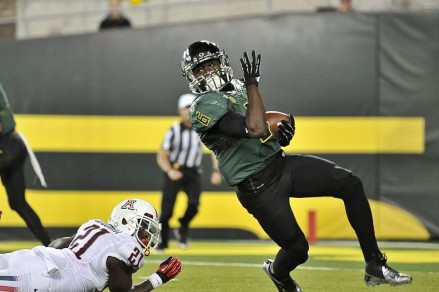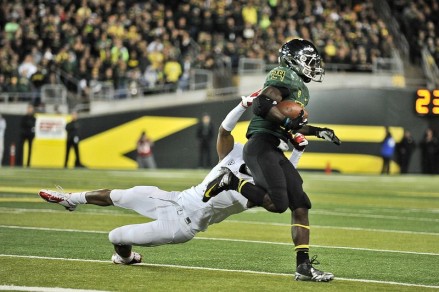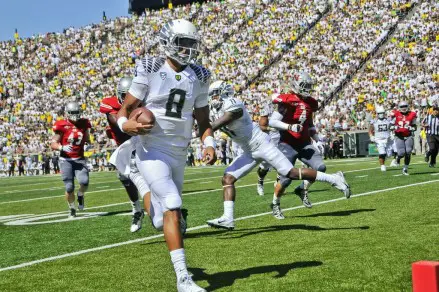Kevin Cline
The Oregon Ducks made a nice statement to kick off the 2013 season. While all the news media and analysts were busy talking up Alabama, Ohio State, Stanford and Johnny Manziel, the Ducks were setting school records on their way to 66 points. Oregon’s brand of football often results in big wins. The Ducks’ uptempo attack allows them to jump out to early leads, discouraging their opponents and often leading to enormous margins of victory with video game stats on offense.
This is often unfortunately used to take away from Oregon’s wins. Many argue that the hurry-up offense allows for easy points and that big blowouts are simply a result of this system. How the success of “the system” takes away from the success of the team, is beyond me. Yet, for many, this argument still slaps the “gimmick” stamp on the Ducks.
It really was quite odd how little time and energy was spent talking about the Ducks this offseason. It is almost as though their consistent elite success over the past four years has turned them into a “default” top-five team. However, Oregon’s offense remains the best and most electrifying in recent memory.
Oregon opened the season about as well as it could have. It may have just been Nicholls, but there were still 11 college football players on that field whose sole job it was to stop the Ducks. What Oregon’s offense did to that team was utter domination.
In his first game as head coach, Mark Helfrich proved that Chip Kelly was not the only ingredient in the Oregon Ducks’ success. The team posted a school record 772 total yards on its way to 66 points, marking one of the biggest victories in Oregon history.
But where does it rank among some of the school’s other big blowouts?
It comes as no surprise that we only need to look back as far as 2010 to examine two of these games. That year, the Ducks opened with a 72-0 win over New Mexico and beat Portland State 69-0 two weeks later. Despite scoring more points than its win over Nicholls, Oregon posted 720 total yards against New Mexico, 52 fewer than against the Colonels. This remains the school’s largest margin over an FBS team in the modern era.
The 72 points posted against New Mexico are also tied for the most in the modern era, with Oregon’s 1999 win over Nevada. That day, the Ducks racked up 562 total yards on offense on their way to a 72-10 victory. Against Portland State in 2010, Oregon posted 668 total yards, including an overwhelming 511 yards on the ground.
One has to go back more than a century to examine the largest margin of victory in school history. Though it was a completely different era, the Oregon Webfoots managed to beat Puget Sound 115-0 in 1910. While few stats were recorded at the time, it involved a 10-touchdown day from all-around star Charlie Taylor. Given the differences in the nature of both the game and competition level between 1910 and 2013, it is truly hard to compare these games. Nonetheless, the Puget Sound game remains easily the largest difference the program has ever seen.
In 2012, the Ducks were on pace for a record-breaking night against Arizona State. After losing a fumble on the second play from scrimmage and giving up a touchdown on the ensuing play, Oregon bounced back to put up 43 unanswered points . . . in only 17 minutes of football. With more than 11 minutes to go in the second quarter, Kenjon Barner scooted into the end zone for the team’s sixth score, and the Ducks were on pace to make history. However, the team took its foot off the gas and settled for a 43-21 win over the Sun Devils, tallying 454 total yards.
All of these games, particularly the victory over Puget Sound, so unbelievably dominant on their own. It is hard to imagine that any one of these blowouts is even comparable to another game. Despite the truly astounding numbers put forth in 1910, 1999, 2010 and 2012, I would argue that Oregon’s performance over Nicholls was the greatest offensive show in Oregon history.
The primary reason is the efficient manner of the win. The Ducks had the ball for fewer than 20 of the game’s 60 minutes, while Nicholls was in control for more than 40 minutes – and still set a school record for total yards.
To put it into perspective, Oregon had the ball for 27 minutes and 20 seconds against New Mexico, 26 minutes and 10 seconds against Portland State, 29 minutes and 24 seconds against Arizona State, and over 33 minutes against Nevada in 1999 (time of possession was unfortunately not a statistic on record back in 1910).
Against Nicholls, the Ducks had the ball for only 19 minutes and 46 seconds. That is 3.34 points per minute and 39 yards per minute (minutes here referring to minutes of offensive possession)! The team had 2.63 points per minute and 26.34 yards per minute against New Mexico and 2.63 points per minute and 25.54 yards per minute against Portland State.
The efficiency of the Ducks’ offense against Nicholls blows out of the water any other win in the modern era. It was also amazing how many players got involved in the action. Seven different Oregon players made it into the end zone, while only four different players scored against New Mexico (not to mention the fact that two of the team’s touchdowns during that game came in the form of Cliff Harris punt returns).
Offensive production certainly does not tell the whole story. The Nicholls win may not have been in shutout form, but the Ducks still only allowed three points and under four yards per play. That is exceptional.
However, it does not quite reach the level of defensive dominance achieved back in 2010, when the Ducks allowed only 2.05 yards per play to Portland State and 1.75 yards per play to New Mexico. It should still be noted, though, that Nicholls never made it past Oregon’s 10-yard line.
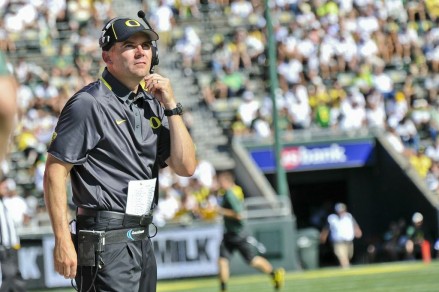
Mark Helfrich could not have asked for a better performance from his offensive during his head coaching debut.
Though it is certainly early in the season, a blowout of this size bodes well for the season to come, based on historical comparisons. The Ducks finished 9-3 in 1999, 12-1 in 2010, and 12-1 in 2012. Though again it is hardly comparable, the Webfoots finished 4-1 back in 1910 as well.
Overall, each of these modern era blowouts are quite comparable in certain ways. Though a 66-3 score may appear to be a slight step down from 72-0 or 69-0, one has to factor in the efficiency demonstrated by the offense during the Nicholls game.
No offensive performance could touch the Charlie Taylor-led debacle of more than a century ago. However, averaging 3.34 points per minute is absolutely ridiculous in terms of offensive productivity. Oregon’s 66 points in 19 minutes and 46 seconds reaches just about exactly 100 points, if extrapolated to 30 minutes time of possession.
Oregon’s win over Nicholls may not be the biggest blowout in school history in terms of points or defense. However, I don’t think there is any doubt that, at the very least, it was the most efficient, productive offensive performance that the Oregon football program has seen since the dawn of the modern era.
________________________________________________
Announcements
*Check out our new pregame opponent analysis on Saturday mornings. Our analysis will be unlike any other, so learn what to watch for before the game on Saturday!
*Want some College Football humor? Check out FishDuck.com‘s GIF Collection! (Click here) Pass it along!
*If you would like to join the other 80+ volunteers at FishDuck.com, and have five hours a week to donate . . . we have slots open for volunteer Editors, Writers, Analysts, Photo Archivists and Social Media Associates. Can you help us manage people? Consider our volunteer Sales Manager and HR Manager positions and give some time each week to help young associates learn! E-mail us at charles@fishduck.com
Related Articles:
Chip Kelly Update: Everything's Good Again ...
Chip Kelly Update: Wailing and Gnashing of Teeth
Shock and Awe -- The Oregon Ducks' Football Hangover Effect
Despite Lopsided Score, Georgia State "Never Stopped Believing"
Hope Springs Eternal for Ducks
Incompetent Pac-12 Officials: How Do You Miss ALL of THIS?
Joey Holland graduated from the University of Oregon in 2013, majoring in History. He played several sports in high school, though football remains his passion. He has yet to miss a single Oregon Ducks home football game during his time in Eugene. Joey has written previously for Bleacher Report and Football Nation.
Joey welcomes your feedback.

